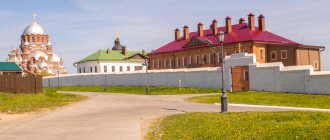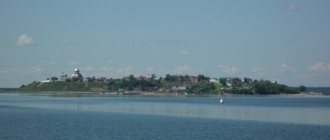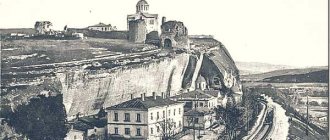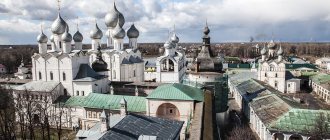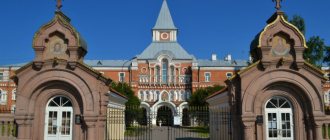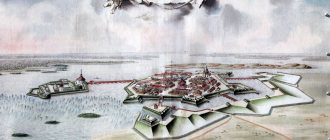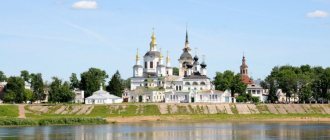2. Historical pedestrian.
Cost - 2500 rubles per group, for 11 and the next person - 250 rubles each. The price includes a visit to the permanent exhibition of the main building of the Sviyazhsk History Museum.
Duration: 2.5 hours.
3. Walking tour “Through the prism of centuries.”
Cost - 2700 rubles per group, for 11 and the next person - 270 rubles each. The price includes admission to all permanent exhibitions and exhibitions of the Sviyazhsk History Museum.
Duration: 3 hours.
4. Walking tour “The Legend of the Land of Sviyazhsk”.
Cost - 3700 rubles per group, for 11 and the next person - 370 rubles each. The price includes a visit to the Sviyazhsk History Museum and participation in the interactive program “Streltsy Fun”.
Duration: 3 hours.
5. Walking tour “Leafing through the past of Sviyazhsk”.
Cost - 3900 rubles per group, for 11 and the next person - 390 rubles each. The price includes a visit to the Museum of the History of Sviyazhsk, the Horse Yard and participation in the interactive program “Streltsy Fun”.
Duration: 3.5 hours.
6. Children's walking tour for children 7-13 years old “On the island of Buyan, or in the kingdom of the glorious Saltan.”
Cost - 2500 (4500 for 3 hours) rubles per group, for 11 and the next person - 250 (450) rubles each. The price includes a visit to the Museum of History of Sviyazhsk, the Skazka children's leisure center and participation in the interactive program “Streltsy Fun”.
Duration - 2.15 or 3 hours.
Brief history of Sviyazhsk
Sviyazhsk has a rich history associated with the annexation of Kazan to the Russian state. The town was conceived as a fortification, which was supposed to help Ivan IV the Terrible conquer the Kazan Khanate. In 1550, the tsar saw a wonderful place - Mount Round, on which it was decided to organize buildings.
Sviyazhsk was conceived as a fortress city
Engineer Ivan Grigorievich Vyrodkov designed a fortress, which was built near Uglich, all the components were numbered and disassembled to be sent along the waves of the Volga River to Round Mountain. Sviyazhsk was built in 1552 in just a month, but at the same time it had all the necessary infrastructure. A year after its construction was completed, the current capital of Tatarstan was conquered.
So Sviyazhsk became the largest trade and administrative point - foreign merchants began to come here. At the same time, monastery and church buildings were erected in the settlement, which is why the city eventually turned into a monastery. Life here has calmed down, becoming quiet and blessed. After some time, the settlement acquired the status of a county town, and in 1781 acquired its own coat of arms.
The coat of arms of Sviyazhsk depicts a city sailing on a ship with fish splashing under it
The revolutionary times had a bad impact on the architecture of Sviyazhsk: churches were destroyed and looted, most of them were converted into prison cells and penal colonies. Then the island completely became part of the Gulag camps.
In 1957, the Kuibyshev State District Power Plant was launched, which caused part of Sviyazhsk to be flooded. The road that connected the town with the mainland was covered with water - the settlement ended up on a real island, and the number of inhabitants sharply decreased by almost ten times. The year 2008 was marked for Sviyazhsk by the opening of a new dam with a highway, which reconnected the town with the land. Today Sviyazhsk is a world heritage site according to UNESCO. Architectural objects and religious buildings are restored and restored here.
Video: Sviyazhsk from above
Interesting Facts. Monument to Judas
to Judas allegedly discovered on the territory of Soviet Russia.
. The installation of the monument was supposedly personally directed by Leon Trotsky. This famous revolutionary was sometimes called the "demon of the revolution."
According to legend, the format of the monument to the main biblical villain was approved by Lenin himself. It is believed that Trotsky initially wanted to erect a monument to Lucifer himself. However, Lenin banned this project, since the installation of such monuments would indirectly confirm faith in God. The project for a monument to Cain was also rejected by the leader of the world proletariat. Therefore, the revolutionaries converged on a monument dedicated to Judas.
According to legend, the opening of the monument took place with an orchestra and a parade of two Red Army regiments. After the fabric was torn from the monument, the amazed residents of the city saw a full-length stone human figure. The Judas monument depicted a crouching biblical antagonist with his arms raised. Rumor has it that the prototype of the monument was Trotsky himself.
Of course, this story is 100% fiction. Similar rumors were spread by former White Guards who were forced to immigrate from the country after the Bolshevik victory. There are quite a few references to the existence of monuments to Judas in Soviet Russia. In particular, the famous Danish diplomat Henning Koehler writes about the monument in his memoirs. He claimed to have witnessed its installation in 1918.
Let us note that many contemporaries fully trusted such rumors, since they were hostile towards the Bolsheviks. In particular, the famous Russian writer Ivan Bunin believed the information about the installation of the monument to Judas. Naturally, nothing like this ever happened.
There is a completely logical explanation for these rumors. The commander of the Red Army who took Kazan was the famous leader of the Latvian riflemen. His name was Yan Yudin
. During the fighting, this officer was killed. Moreover, the date of his death approximately coincides with the time of installation of the “monument to Judas.”
In fact, they were talking about the funeral of Yan Yudin. A monument was actually erected to him. It is known that he died from an accidental shell fired by the White Army artillery. The Dane Köhler could well have confused the consonant surname with “Judas”.
How to get there
It is more convenient to get to Sviyazhsk from the capital of Tatarstan - Kazan. There are several ways to get to the island:
- By car you need to drive along the M7 highway towards Moscow. Having passed the village of Isakovo, after the junction you should turn right - there you will see an old wooden mill, which will become a landmark. The entire journey is about 60 km;
- You can get from Kazan to Sviyazhsk by bus only on weekends. There is only one flight from the Central Bus Station, the ticket price for which is 165 rubles. However, a sightseeing bus departs daily from the Yuzhny bus station to your destination. You will have to pay 500 rubles for travel;
- by train. Sviyazhsk Island is located 14 km from the railway station, so when you get there by train, you will need to call a taxi (about 250 rubles) or hitch a ride. The train makes eight trips a day and travels for 90 minutes. A ticket costs about 100 rubles;
- by water transport. The motor ship from the river port of Kazan, located on Devyataeva Street, 1, departs for Sviyazhsk daily at 8:20. The entire journey takes approximately 2 hours 30 minutes, the ticket price is about 150 rubles. The ship departs back at 16:30. You can spend more than 5 hours on the island, which is enough to explore its attractions. Flights operate from early May to mid-October.
Sviyazhsk station is located in the village of Nizhnie Vyazovye, 14 kilometers from the island itself.
Sviyazhsk is a pedestrian island, so you won’t be able to get around it by private car. The car will need to be left in the parking lot upon entering the settlement.
Infrastructure of Sviyazhsk: entrance, parking, cafes, hotels and prices
Entrance to the reserve is free, but you need to get an entrance ticket from a special machine in order to go through the turnstiles. If you want to visit museums on the island, you will have to pay separately or buy a single ticket. The price list is listed on the official website. I will not give numbers here, as they may change.
This is what a free ticket looks like
Terminal inside information class=”aligncenter” width=”1024″ height=”768″|fcw3qayjh5a| src=”https://kudago2.com/wp-content/uploads/2018/07/IMAG4963-01.jpg” class=”aligncenter” width=”1024″ height=”768″[/img]
From an abandoned village, Sviyazhsk has turned into a developed tourist center; of course, the changes have somewhat diminished the historical spirit, but not everyone will like looking at the devastation either.
There is a large parking lot at the entrance, but it does not always cope with the load on weekends. If the parking lot is full, you can stop pushing and leave your car on the side of the road.
By the way, another parking lot was built this year, but it is located about two kilometers from the island. Why they did this is unknown, it’s a long walk, maybe they’ll let you in from there (or they’ve already started buses to the island)
Next you need to climb the stairs, since the city is located on a hill.
It will not be easy for people with limited mobility to get up here, but there is a climb without stairs, it is located behind the barrier and the security booth. The security guards will not object if you, when transporting a disabled person or grandmother, take them upstairs in a car. This has been tested in my experience. For which, of course, great respect!
Having passed through the barrier, you can go straight up to the Church of “Joy of All Who Sorrow” or drive to the pier. Cars will not be allowed through without a good reason.
Descent and ascent for cars
When to come
It is better to visit the town of Sviyazhsk in the warm season - from May to October. In July, the air temperature rises to +25 °C, in August - to +30 °C, but the island is not hot and stuffy. But the beginning of summer may seem cold - only +15 °C. In winter, Sviyazhsk is not very comfortable - deserted and frosty, as frosty winds blow from all sides. If you are not afraid of cold weather and -18 °C (and on the island it feels like -35 °C) you are not afraid, then you can visit Sviyazhsk in winter. At this time of year, excursions are also held here, hotels are open, but prices are no lower than in the summer season.
Winter Sviyazhsk - cold and deserted
Almost all the main holidays of the island fall during the warm season:
- The founding day of Sviyazhsk is held on May 24;
- in April, in honor of Fyodor Chaliapin, the annual All-Russian Sviyazhsk Festival of Sacred Music is held;
- On June 12, a festival dedicated to the folklore of the Volga peoples takes place;
- In July, two sporting events are held at once: the Buyan Island fencing tournament;
- competition in archery and crossbow shooting "Sviyazhsk Cup".
Museum "Tatar Slobodka"
From the boat we will go up the path to a unique repository - the museum of the archaeological tree “Tatarskaya Slobodka”. On the territory of Sviyazhsk it is impossible to disturb the natural landscape with modern buildings, so the museum was disguised as a hill.
In the 16th - 18th centuries. there was a Tatar settlement in this place. The remains of wooden buildings were left where they were discovered. And around them in glass cases there is an exhibition: tools and ancient weapons, kitchen utensils, leather shoes and even toys. All this was found at the excavation site.
The highlight of the museum is a huge animated panel. The life of a 17th-century settlement is reproduced in animation mode.
Believe it or not, there are 450 different characters involved in 100 everyday scenes! The animation characters saw logs, build, fish, wash clothes, put out fires, and simply go about their business.
This museum is a must visit!
What to see with your child
If you are visiting Sviyazhsk with a child, then excursions tailored to the child’s age will be selected for you. The little ones will be able to take a walk along “Buyan Island” or “Pushkin Lukomorye”, and older children will enthusiastically visit the ruins of the fortress, listen to legends about it and climb to its highest point.
There is a legend that Alexander Pushkin, sailing past the island of Sviyazhsk, exclaimed: “But this is my island Buyan from the fairy tale “About Tsar Saltan”!
Children will also be interested in the historical playground called “Lazy Torzhok”, located on Rozhdestvenskaya Square. Here you can take part in historical battles, trying on the role of a warrior, watch knightly fights, study military costumes and even make a souvenir with your own hands. Entrance to the site by ticket, price - 80 rubles.
In the Lazy Torzhok complex you can watch the battles of knights
Cannon "Devka's head"
Sviyazhsk, created as a fortress, had the latest weapons for that time - cannons. Each of them was different from the other, had its own name and stood in different places of the fortification. The city's Nativity Gate was defended by the Devkin's Head cannon. She got her name thanks to the image on her gun carriage of a female head, similar to the Gorgon Medusa. The cannon installed in front of the local history museum is a copy, created according to drawings found in ancient chronicles.
How long does it take to look around the island?
One day is enough to get acquainted with the sights of Sviyazhsk, and this will not be a superficial, but a thorough study of the town.
A tourist map will help you quickly find your way around Sviyazhsk
The tour should start from Uspenskaya Square. Here you can visit the Craft Museum and the Horse Yard, and then go to the ancient Sviyazhsk Mother of God Assumption Monastery, located to the left. On its territory, see the Assumption Cathedral and the Monument to the Victims of Political Repression.
Assumption Square is located at the entrance to the island
You should also look into the “Island-city of Sviyazhsk”, the Historical and Civil War Museum, located nearby. Then take a walk along Rozhdestvenskaya Square, which offers amazing views of the Sviyaga River. The next point is the interactive town “Lazy Torzhok” and the local observation deck.
Sviyazhsk Island offers beautiful views of the rivers
Next, visit the Church of Constantine and Helena and St. John the Baptist Monastery. Here are the Trinity and Sergius churches, as well as the Cathedral of the Icon of the Mother of God “Joy of All Who Sorrow” and the Chapel of Nicholas and Alexandra.
Mother of God Assumption Monastery
The Assumption Monastery of the Mother of God, founded in 1555, is the oldest and richest Orthodox monastery in Tatarstan and the Volga region. Masterpieces of ancient Russian architecture located on the monastery territory are the bell tower of the Church of St. Nicholas the Wonderworker and the Assumption Cathedral. Also in the monastery complex there are buildings from the 17th century - a two-story archimandrite building, reminiscent of a Russian tower, fraternal buildings and churches in honor of Saints Mitrofan of Voronezh and Herman of Kazan.
Assumption Cathedral
The majestic Cathedral of the Assumption of the Blessed Virgin Mary belongs to the authorship of the famous Russian architect Postnik Yakovlev-Brama, who built the Moscow St. Basil's Cathedral. Tourists and believers are amazed by the extensive fragments of fresco painting from 1561, preserved on an area of 1080 square meters. They depict scenes from the Bible, Gospel and apocryphal legends in the manner of Western European church painting. Under the dome of the cathedral you have the opportunity to see an icon depicting St. Christopher with the head of a horse and a unique fresco depicting Ivan the Terrible. The “Ukrainian Baroque” appearance in which the temple appears today was given to it in the 18th century. Then the cathedral, crowned with a new dome, grew due to the addition of 12 kokoshniks.
Church of St. Nicholas the Wonderworker
The building of the St. Nicholas Refectory Church, erected in 1555-1556, became the first stone structure of this type of religious architecture in the entire Volga region. The three-altar church building, modeled on the church-bell tower, was built by Pskov masons and reflected the architectural details characteristic of Pskov churches. Inside the temple there are remains of a fresco depicting the face of St. Nicholas of Mozhaisk. The church-bell tower of St. Nicholas the Wonderworker majestically rises 43 meters above Sviyazhsk and serves as a landmark on the way to the Assumption Monastery.
Tips for staying in Sviyazhsk
Sviyazhsk is a small island, so tourists often spend one day here. However, if you want to stay in the village for a longer period, then you need to think about your place of residence in advance.
Where to stay overnight
There are several hotels on the territory of Sviyazhsk:
- hotel "House of Merchant F. T. Kamenev". The interior of the establishment is stylized as a merchant's estate. All furniture and accessories are made to order and are designed to return hotel guests to the atmosphere of the 19th century. There are only eight double comfortable rooms. Price for overnight stay - from 3 thousand rubles. for two/day. Address: Rozhdestvenskaya Square, 2;
The hotel “House of Merchant F. T. Kamenev” is designed in the style of a merchant estate - The Sviyaga hotel is also located in a historical architectural building - the building of the Almshouse, built in the 19th century. There are seven rooms (four doubles and three singles), which are named after fish that live in the rivers of Sviyazhsk. The downside of this hotel is the amenities on the floor, but the prices here are much lower - from 1 thousand rubles. per person/day. Address: st. Moskovskaya, 6;
Hotel "Sviyaga" is located in a historical building - The hotel “Monastery House of the Pilgrim” is located next to the Mother of God Dormition Monastery. There are rooms for four, six, eight and sixteen people. Prices: from 350 rubles per person per day. Address: st. Troitskaya, 3.
The hotel "Pilgrim's Monastic House" looks very strict inside and out
What to bring from the island
In Sviyazhsk you can purchase both ordinary souvenirs in the form of magnets, wooden or clay crafts, textile decorations, and items typical of the life of past centuries. The main part of the shops and souvenir shops is located on the territory of the Horse Yard. The Lenivy Torzhok complex also sells memorabilia:
- clay pots;
- birch bark figurines;
- painted plates;
- coins;
- medallions;
- horseshoes.
In Sviyazhsk you can buy souvenirs for every taste
19th century secular buildings
Sviyazhsk was a county town with typical architecture of its time. But thanks to its “isolation” from the outside world (it became an island after most of the area was flooded due to the construction of the Kuibyshev hydroelectric station in 1955), the civil buildings of the 19th century were not rebuilt and were preserved in the best possible way (as, for example, in Torzhok ). The street names are pre-revolutionary. Here you will see residential (Uspenskaya and Nikolskaya streets) and government houses (Uspenskaya street), barracks of an engineering regiment (Uspenskaya street), a city school, a building of a lower vocational school (on the central square) and other buildings.
Ethnographic complex "Horse yard"
Opposite the monastery is an interesting place. This is the ethnographic complex “Horse Yard”.
The history of the complex dates back to the 16th century, when the monastery acquired its own stable. The original structure was wooden. In the 18th century it is being rebuilt from stone.
The tourist complex consists of several craft workshops: pottery, leather, and blacksmithing. There are also stables, souvenir shops, and the Traktir restaurant. All buildings are connected to each other and form a closed courtyard. And in the center of it is a riding arena.
Horse yard.
Let's look into the workshops and take part in blacksmithing or pottery. At the national costume shop, we’ll dress up and take a memorable photo. And then we’ll ride some thoroughbred horses.
Trinity Church
Trinity Church is the oldest building in Sviyazhsk. This wooden structure was made without a single nail. Construction was carried out under the leadership of the first Russian military engineer, clerk Ivan Vyrodkov. It is to him that historians attribute the idea of building Sviyazhsk. The fortress was cut down many kilometers from the site of construction, in the city of Myshkin. Then all the logs were numbered and secretly transported to the banks of Sviyaga. In a matter of days, powerful fortifications were erected 30 kilometers from the then enemy Kazan, which played a huge role in its capture by Russian troops in 1552.
The carved iconostasis, wooden images of saints, and ancient icons give the temple a discreet coziness, and the knowledge that Ivan the Terrible himself could communicate with higher powers here makes the temple one of the most attractive places in Sviyazhsk.
Location: Troitskaya street - 3.
Useful information for tourists
Since the 18th century, Sviyazhsk received the status of a county town. The proximity of its location to the Volga, which at that time was the main waterway of the region, ensured the rapid development of trade and an increase in the number of residents of the town. In 1955, the leadership of the USSR decided to begin construction of the Kuibyshev hydroelectric power station.
The project was implemented in a short time, which led to the construction of a dam, changing the course of the Sviyaga River and flooding vast areas. Most of the city of Sviyazhsk was under water. The river forever swallowed up churches, merchant houses, military and vocational schools, and barracks. Present-day Sviyazhsk, which remains on the island, is a small part of a previously large city with a rich history.
This information attracts tourists who are interested in diving. In the summer, they come in organized groups, stop on the shore of the Kuibyshev Reservoir, and explore its bottom, which keeps a huge number of secrets and artifacts. Most of the objects found at the bottom of the reservoir are of historical and cultural value.
There are several ways to get to Sviyazhsk and its attractions, namely:
- fly to Kazan airport by plane, then take a taxi and go to the river station, from where every 30 minutes. A pleasure boat departs towards the Sviyazhsk pier;
- get to the city in your own car, following the M7 highway, which is also known as Gorkovskoye Highway (the distance from Kazan to Sviyazhsk is no more than 70 km);
- while at the Kazan railway station, take one of the commuter trains heading in the direction of Albaba, Kanash, or Bua, get off at Sviyazhsk station (the island is 15 km away, so you will need to use public transport or take a taxi).
The experience of the majority of tourists surveyed shows that it is best to get to Sviyazhsk and its attractions along the above-mentioned highway, or by using the river transport. In the latter case, on the way to the island you can enjoy the picturesque beauties and landscapes of the Volga region.
Article design: Oleg Lozinsky
